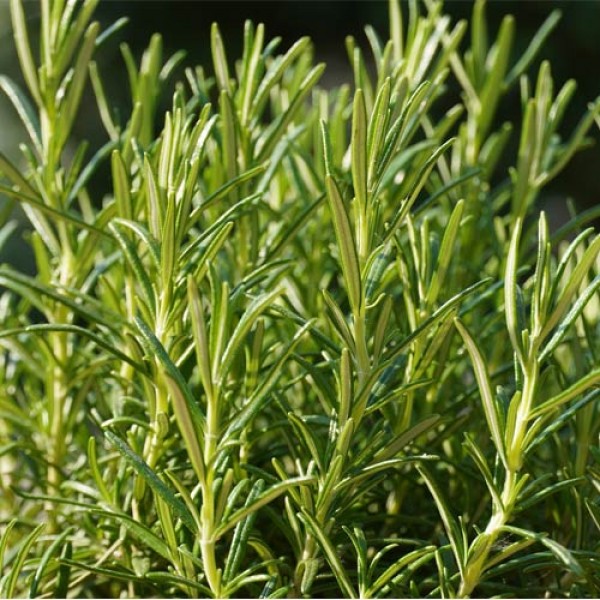Sowing rosemary
How to grow rosemary from seeds
With its fragrant needles, rosemary greens the steep coastal slopes of Portugal, the mighty limestone cliffs of the Greek archipelago, the colourful maquis of Spain and Italy and the evergreen shrub heaths of France. In summer, its sky-blue flowers attract bees and bumblebees with their scent, and the morning dew collects in its blossoms. This is why the name of rosemary means "dew of the sea". The hot Mediterranean sun has made the rosemary`s needle-like leaves waxy and tough. The strong essential oils also protect it against diseases and pests.
Location
In its natural habitat, rosemary grows in the poor soils of the Mediterranean coastal landscape. For you, this means that you should lean fertile, heavy soils with a shovelful of sand, gravel or lime. This reduces the nutrient content of the soil making it more permeable for the rosemary, which does not tolerate waterlogging. Rosemary needs full sun for producing a high concentration of essential oils that give it its typical aroma and healing power. Rosemary loves a spot near a south-facing house wall or the driest and sunniest spot in the garden.
In a herb spiral plant rosemary on the top of the spiral. Ideal neighbours in mixed cultures are other Mediterranean herbs, such as sage, oregano and thyme. If you don`t have your own garden, you can also put the rosemary in a pot on the balcony or terrace. This way you will always have a sprig of fresh rosemary at hand when cooking. Bear in mind that rosemary will become a relatively large shrub. Give it a larger area to grow right from the start.
Sowing
It is not easy to grow rosemary from seed because it needs very high germination temperatures and takes a long time to germinate. To grow rosemary from seed, sow it under glass or foil in spring from mid-March. We recommend growing it indoors from March in a mini-greenhouse or propagator, using a heating mat if possible. Alternatively, you can sow it in a cold frame from mid-April. With a sowing depth of approx. 0.5 cm and a germination temperature of 18-22°C, the germination period is 2 - 3 weeks.
Care
As a Mediterranean coastal shrub, rosemary is adapted to great drought, wind and heat. This hardiness will suit you in your garden because rosemary does not make any great demands on its soil and care. Fertilising is therefore neither necessary nor advisable. Like almost all other plants, rosemary wants to be kept free of weeds.
If you cut rosemary back in winter, you can raise it to a denser and more abundant growth. In winter, you should protect frost-sensitive rosemary with a cultural protection net. For rosemary grown in pots, it is essential to protect the roots from frost. It must not be exposed to frost. If you have a place in the winter garden or a cool but bright cellar or staircase, move it in when the thermometer drops below -5°C.
Flowering
Rosemary flowers from mid-March to the end of May. If the shrub is cut back completely after that, a second flowering is possible in July and August. In Mediterranean regions, the flowering season is October.
As the flowers of rosemary are by no means as flavour-intensive as the other parts of the plant, the flowers are used rather as decoration.
Protection from pests and diseases
Rosemary is not very susceptible to diseases and pests because of its essential oils. Especially outdoors, rosemary is a very healthy plant. In a pot on the balcony or windowsill, however, pests or diseases can attack it from time to time.
- Aphids, scale insects, mealybugs, spider mites: Treat infested rosemary stems three to four times with soapy water or cut out the affected areas. Outdoors, beneficial insects can also be used against the pests.
- Powdery mildew: The fungal disease threatens if the plants are planted too close together. Keep a larger planting distance.
- Grey mould (Botrytis cinerea): This fungal disease often occurs in winter quarters under too humid conditions.
- Yellow needles and root rot: These occur when the rosemary is too wet. Plant the rosemary in a warmer, sunnier location and water less.
Harvest
Harvest rosemary in the late morning on warm, sunny days, when the essential oil content is highest. In addition, the half-shrub should be dry. It is best to cut off whole shoot tips with a clean, sharp knife or secateurs.
You can cook this whole in your dish or dry the excess needles in the sun or on baking paper at 30 degrees. More tips on storing and preserving rosemary are given below.
Store
Freshly harvested rosemary twigs can be stored for about 7 - 14 days. To do this, wash the rosemary and then pat or rub the twigs dry. This is important because wet rosemary quickly becomes slimy. Then wrap the herbs in damp, not wet, kitchen paper and place them in a sealable freezer bag in the vegetable compartment of your fridge. Alternatively, you can place the rosemary sprigs in a glass of water, preferably right after you have freshly cut them. (This is also a good way to propagate, as rosemary in a vase takes root quickly and can then be potted up).
There are several ways to preserve rosemary. For example, freezing or drying rosemary is very suitable.
Drying rosemary
Like many other Mediterranean herbs, rosemary can be preserved by drying:
- Gently shake off the rosemary sprigs before drying to remove dust and dirt.
- Remove the leaves at the bottom of the stem and gather several rosemary sprigs into small, airy bundles. These are then tied together with string.
- Hang the rosemary bunches in a dry, clean and dark place. Avoid direct sunlight, this will cause a lot of the Mediterranean aroma to be lost.
- The rosemary should be checked regularly. When the leaves fall apart in your fingers, it is completely dried. This usually takes a few weeks, but can also take months.
- Finally, you can separate the leaves from the stems and store the leaves in an airtight, labelled container.
- This way rosemary will keep for a year or more.
- If you don`t have that much time, you can dry the rosemary in the oven. Set a maximum temperature of 30 °C and open the oven occasionally to let the moisture out.
Freezing Rosemary
- Wash the rosemary sprigs thoroughly and dry them well.
- Leave the leaves on the stem and spread the sprigs out on a baking tray so that the individual shoots are not touching.
- Place the baking tray in the freezer for a few hours to freeze the twigs. This prevents the stems from freezing together and makes it easier to remove individual branches later.
- Once the rosemary is well frozen, the sprigs are transferred to a labelled freezer bag and stored in the freezer to save space.
- The rosemary can be preserved in this way for a year or more. The rosemary does not need to be thawed for cooking, it can be used directly from the fridge.
Another option is to pickle rosemary in olive oil. The needles removed from the twigs and chopped into small pieces are placed in a container and then filled with good quality olive oil. The Mediterranean plant can also be made into rosemary syrup, which adds a special note to tea or refreshing drinks.















